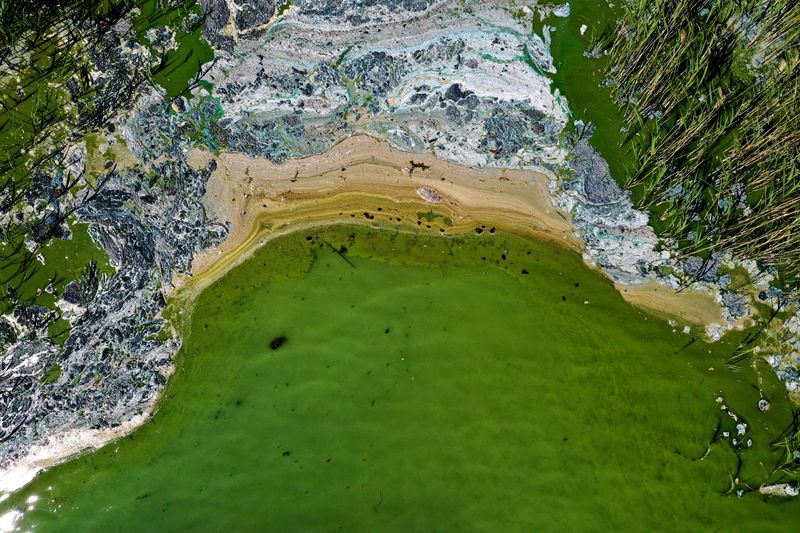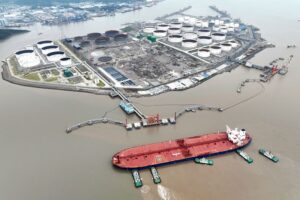
Phytoplankton blooms see two-decade surge along world’s coastlines
Phytoplankton blooms see two-decade surge along world’s coastlines By Reuters
Breaking News
‘;
Commodities 11 hours ago (Mar 01, 2023 12:13PM ET)
3/3
(C) Reuters. FILE PHOTO: An aerial view of toxic blue-green algae bloom on the Baltic Sea coast at Tyreso near Stockholm, Sweden, June 25, 2020. Pontus Lundahl/TT News Agency/via REUTERS
2/3
By Gloria Dickie
LONDON (Reuters) – Huge blooms of phytoplankton — microscopic algae floating on the ocean’s surface — have become larger and more frequent along the world’s coastlines, according to new research, bringing benefits to fisheries but also potentially causing harm.
Between 2003 and 2020, coastal phytoplankton blooms increased by about 13% in extent, covering an additional 4 million square kilometres of the global ocean, the Nature study found. And the blooms occurred more often, up by 59% during that period.
While marine animals such as fish and whales eat phytoplankton, it can also prove toxic in large amounts, starving the ocean of oxygen and leading to “dead zones” that wreak chaos on the food chain and fisheries. A 2016 algal bloom near Chile, for example, cost salmon farms $800 million.
“Phytoplankton blooms can be really beneficial,” said study co-author Don Anderson who leads the U.S. National Office for Harmful Algal Blooms at Woods Hole Oceanographic Institution. “Many of the really productive fisheries in the world’s ocean are driven by blooms. It’s important to understand why they might be changing.”
Scientists used satellite observations to look for blooms, programming a system to pick up the colour of the algae. However, they weren’t able to distinguish between benign and harmful blooms.
While some regions saw weaker blooms over the past two decades, including the California Current, blooms strengthened in the northern Gulf of Mexico and the East and South China Seas.
BEHIND THE BOOM
What’s driving the increase in phytoplankton blooms varies by region, scientists said. In some cases, warmer sea surface temperatures appear to be behind the boom. Changes in climate can also mess with ocean circulation, affecting mixing between ocean layers and how nutrients move around the ocean.
Human development also plays a role. Fertilizer runoff from agriculture can spike nutrient loads in the ocean, leading to blooms. Researchers also found that more aquaculutre around places like Finland, China, and Vietnam might be associated with more algal blooms.
Outside of fertilizer use and aquaculutre, “I would also be interested in relationships between population increases along coastal areas and bloom increase,” said Nandita Basu, a Canada Research Chair in Global Water Sustainability and Ecohydrology not affiliated with the study. “This would be especially relevant for some countries in the southern hemisphere where a major part of the domestic waste is not treated.”
Phytoplankton blooms see two-decade surge along world’s coastlines
Terms And Conditions
Privacy Policy
Risk Warning
(C) 2007-2023 Fusion Media Limited. All Rights Reserved.
Risk Disclosure: Trading in financial instruments and/or cryptocurrencies involves high risks including the risk of losing some, or all, of your investment amount, and may not be suitable for all investors. Prices of cryptocurrencies are extremely volatile and may be affected by external factors such as financial, regulatory or political events. Trading on margin increases the financial risks.Before deciding to trade in financial instrument or cryptocurrencies you should be fully informed of the risks and costs associated with trading the financial markets, carefully consider your investment objectives, level of experience, and risk appetite, and seek professional advice where needed.Fusion Media would like to remind you that the data contained in this website is not necessarily real-time nor accurate. The data and prices on the website are not necessarily provided by any market or exchange, but may be provided by market makers, and so prices may not be accurate and may differ from the actual price at any given market, meaning prices are indicative and not appropriate for trading purposes. Fusion Media and any provider of the data contained in this website will not accept liability for any loss or damage as a result of your trading, or your reliance on the information contained within this website.It is prohibited to use, store, reproduce, display, modify, transmit or distribute the data contained in this website without the explicit prior written permission of Fusion Media and/or the data provider. All intellectual property rights are reserved by the providers and/or the exchange providing the data contained in this website.Fusion Media may be compensated by the advertisers that appear on the website, based on your interaction with the advertisements or advertisers.

